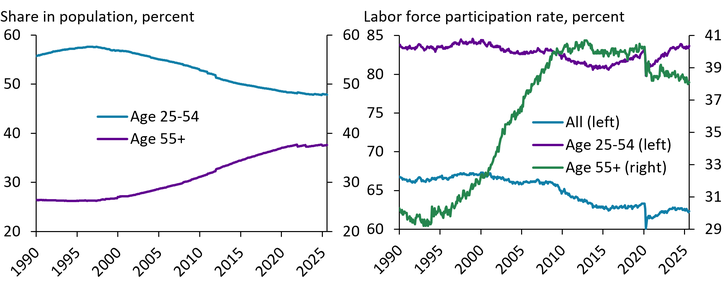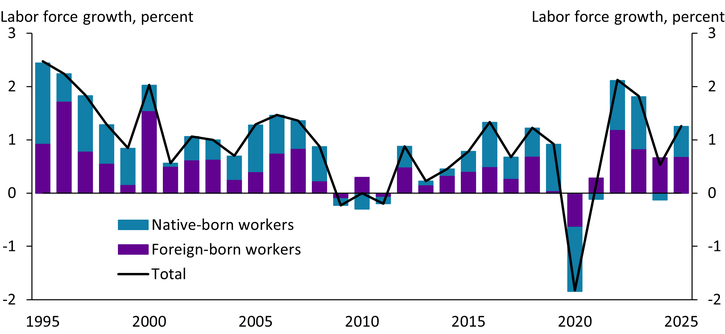Two forces are currently shaping the U.S. labor market. The first is a long-term demographic trend: The U.S. population is aging, and as larger cohorts of workers reach retirement, growth in the labor force slows. The second is the recent decline in net immigration, which puts further downward pressure on labor force growth. Together, these two forces reduce “breakeven” employment growth, or the number of new jobs required to maintain a stable unemployment rate. Understanding breakeven employment growth may help contextualize recent soft payroll readings.
The median age in the United States increased from 32.9 in 1990 to 39.1 in 2024, and this demographic shift has contributed to a decline in the overall labor force participation rate. The left side of Chart 1 plots the share of prime-age individuals (age 25 to 54 years) and those over age 55. In 1990, prime-age individuals accounted for more than half of the population, but this share has steadily declined over time (blue line), offset by a rising share of older individuals (purple line). The right side of Chart 1 shows that the overall labor force participation rate has trended down since 1990 (blue line), despite high participation among prime-age individuals (purple line). Although the labor force participation rate among individuals over 55 has increased (green line), it is significantly below that of prime-age workers. By shifting the composition of the labor force to those with lower participation, an aging population has reduced the overall labor force participation rate.
Chart 1: An aging U.S. population has contributed to a decline in the labor force participation rate

Sources: U.S. Census Bureau and U.S. Bureau of Labor Statistics (accessed via Federal Reserve Bank of St. Louis, FRED) and author’s calculations.
Historically, immigration has offset older workers leaving the labor force. Chart 2 shows that foreign-born workers (purple bars) have consistently accounted for half of labor force growth each year, an outsized contribution given their much smaller share of 19 percent of the labor force._
Chart 2: Immigration has made an outsized contribution to labor force growth

Note: Monthly data are annually averaged.
Sources: U.S. Census Bureau and U.S. Bureau of Labor Statistics (IPUMS); author’s calculations.
However, immigration has slowed in recent months due to stricter policies. The left side of Chart 3 shows that the foreign-born share of both the population (green line) and the labor force (dark blue line) dropped recently after years of steady increases. The right side of Chart 3 shows that foreign-born individuals (purple line) have a higher labor force participation rate than native-born individuals (blue line), emphasizing their outsized contribution to labor supply. Thus, the decline in immigration may further weigh on labor force growth and the labor force participation rate on top of the longer-term effects of aging.
Chart 3: Foreign-born individuals have a higher labor force participation rate than native-born individuals

Note: Left-side chart plots the share of foreign-born individuals in the civilian non-institutional population and the labor force. Right-side chart plots the labor force participation rate of native and foreign-born individuals.
Sources: U.S. Census Bureau and U.S. Bureau of Labor Statistics (accessed via Federal Reserve Bank of St. Louis, FRED); author’s calculations.
One way to understand the effects of slower labor force growth on the labor market is to look at “breakeven employment growth,” or the number of new jobs required each month to keep the unemployment rate constant at a target level. This measure depends directly on labor force growth and hence on both demographic and immigration patterns, and it serves as a benchmark to compare the payroll employment numbers reported in each month’s Employment Situation Report published by the U.S. Bureau of Labor Statistics (BLS)._
Table 1 reports the monthly breakeven employment growth values under various scenarios for population growth, labor force participation, and unemployment, and highlights the effects of aging and immigration on this benchmark number. The top panel of the table uses the 2026 population growth projections from the Congressional Budget Office (CBO), assuming an overall labor force participation rate of 62.3 percent and a value of 4.4 percent for the unemployment rate as also projected by the CBO. The projection released in January 2024 implies a monthly breakeven employment growth of 150,000 jobs. This estimate fell to 126,000 jobs in the projection for the same period released in January 2025, when the CBO revised down its estimate of immigration’s contribution to population growth while keeping the contribution of net births the same. By September 2025, the CBO had further revised down its estimate of net births’ contribution to population growth, resulting in a breakeven employment growth of 77,000 jobs. Using this figure and netting out the contribution of immigration to population growth yields an even lower breakeven number of 29,000 jobs.
Table 1: Aging and immigration have a direct effect on monthly breakeven employment growth

Sources: CBO, BLS, and author’s calculations.
The lower panel of Table 1 takes a longer-term view of the labor market, using the CBO’s most recent population projection for 2034, a labor force participation rate of 61.1 percent as projected by the BLS, and the median longer-run unemployment rate in the Summary of Economic Projections of 4.2 percent. These projections result in a breakeven employment number of 52,000 jobs.
Overall, Table 1 suggests that long-term demographic shifts and recent policy changes on immigration may result in significantly lower monthly breakeven employment growth numbers, offering some context for the employment growth numbers that were revised down in the last few months. For example, payroll growth in July and August 2025 were 79,000 jobs and 22,000 jobs, respectively. These numbers could be interpreted as signs of softening labor demand. However, considering the breakeven employment estimates in Table 1, these payroll numbers may not indicate an overly weak labor market and may be consistent with the recent relatively stable unemployment rate.
More broadly, the combined effects of an aging population and lower immigration have several long-term implications for the U.S. economy. With slower labor force growth, output growth will likely have to rely more heavily on productivity gains. Employers may face challenges in filling vacancies, especially in sectors traditionally reliant on immigrant labor, generating upward pressure on wages. And a smaller working-age population relative to retirees may strain public programs such as Social Security and Medicare and reduce the tax base, raising concerns about fiscal sustainability.
Endnotes
-
1
The most recent microdata are available up to and including August 2025. To make the 2025 variables comparable with the previous years, I scale up the immigrant and native labor force by 12/8. To the extent that the foreign-born share in the labor force will further decline this year, this estimate serves as an upper bound on the contribution of the foreign-born on labor force growth.
-
2
Breakeven employment growth is formally defined as Labor Force Growth × (1 – Unemployment Rate), where Labor Force Growth is equal to Population Growth × Labor Force Participation Rate. As the breakeven employment growth concept is related to payroll employment measured in the Current Employment Statistics (CES), and other labor market variables (that is, the unemployment rate and labor force participation rate) are measured in the Current Population Survey (CPS), I use a CES-CPS employment ratio conversion factor of 0.976, which is the latest observation as of September 2025. Aging and immigration both affect population growth and the labor force participation rate. For simplicity, I refrain from breaking down the analysis to more disaggregate cells by age and immigration status.
Yusuf Mercan is a senior economist at the Federal Reserve Bank of Kansas City. The views expressed are those of the author and do not necessarily reflect the positions of the Federal Reserve Bank of Kansas City or the Federal Reserve System.
